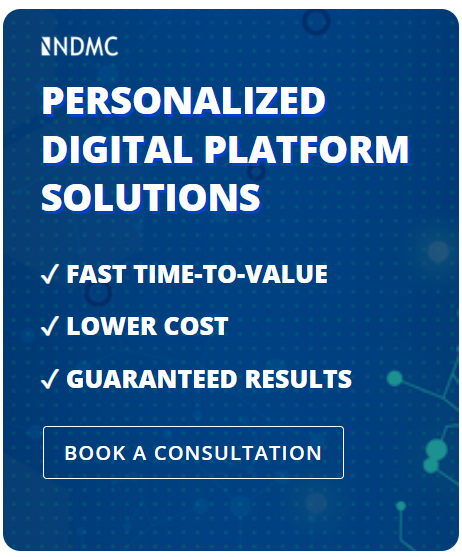How businesses can overcome the digital divide
By Ian Tomlin Jan 12, 2022 at 8:29 am
Business leaders talk about having their finger on the pulse. But, when running a digital business, don’t you need robots to do that?
Barely a day goes by on business social media without a mention of digital transformation in its various forms. Few organizations are not touched by the rapid pace of innovation in the tech space. The face of competition in most industries has been transformed, while government agencies are keen to capitalize on digital solutions like artificial intelligence, chatbots, and the Internet of Things to reduce or remove back-office administrative costs while improving citizen experiences.
The difference between leaders and laggards is culpable, or at least it would be were you able to compare one with the other side by side. We can look at firms like Amazon and Airbnb, and contrast them with organizations that (yes) have a website, but are unable to maintain a real-time, self-service experience throughout their customer journeys. The real-life experience is that relatively few organizations can serve up their entire customer process flow online like Amazon. Fewer still can view performance activities in real-time.
A finger on the digital pulse
As the term suggests, every aspect of a digital business is reflected in data. From the first point of contact, data is captured on a customer, where they go on a website, what they order—and what happens next in terms of the background order processing, logistics, and service interventions that go to make up the value seen by customers.
A true digital business can track every mouse-click, payment, parcel movement, and service request in real-time. They deliver the majority of services to customers online, and use data insights to drive decisioning; helping them to understand buyer demand, fine-tune their finances, optimize stocks, pinpoint process bottlenecks, and improve what they do.
Without this insight, a digital business is running blind compared to its competitive rivals. And one challenge that gets in the way of all this, is manual data processing; closely followed by the use of hard-copy documents.
Personalized digital platform solutions
✓ fast time-to-value
✓ lower cost
✓ guaranteed results

Use of manual processing and documents form digital blindspots
The unfortunate truth is that the humans so often found in the loop of process workflows, and the sporadic use of hard-copy documents to cover over awkward gaps between legal entities, processes steps, and systems, both create digital blindspots in your digital business landscape.
Consider this: You pay a manager to sit there and make decisions. But are those decisions captured in data? Probably not.
And every business runs on activities performed by its people. But do you have a record of those activities articulated in a data table?
Furthermore, does that record explain how those activities are contributing to the objectives in your current strategy (assuming your strategy has been captured in the form of data in a database somewhere)?
Every time a process is interrupted by a manual intervention—a hard-copy form, a key fill data process between systems, etc.—the fluidity and transparency of your digital processes; and their ability to lay bear the performance and opportunity of your business, is compromised.
Software bots are the new supervisors of the enterprise
Back in the day, when the industrial revolution transformed the state of manufacturing, the supervisors on the line were responsible for making sure productivity happened as planned. Today, in the digital era, the production line workforce has been displaced by digital workflows.
Robotic Process Automation (RPA) describes that businesses are increasingly relying on RPA software bots to automate tedious manual processes by replicating what humans do using machine learning and clever algorithms, without having to substantively transform processes. Using RPA, bots are able to transform the productivity of information flows without creating untenable resourcing demands on IT teams.
In this virtualized world, where reality is reborn in binary code, software robots have become the supervisors: They monitor events, track behaviors, expose bottlenecks and make recommendations on how to do things better. It’s easy to imagine that every business a decade from now will have to be able to articulate its operations in a three dimensional virtual reality, with software bots suitable positioned to report back from every juncture of the business where critical events are happening to inform managers of their findings.
Enterprise Application Fabrics – Software to run tens, hundreds, if not thousands of apps and bots
It begs the question, if you are running a business and you know that you’re going to need lots of different ‘tailored to fit’ software applications, data integrations, and bots—to curate the processes that underpin your unique customer offer and its related information flows—then what technology exists to do that?
The answer is an Enterprise Application Fabric. Put simply, it’s a cloud Platform-as-a-Service (PaaS) used to manage the design, deployment, and operation of the digital building blocks of your enterprise. It’s typically built on a private cloud (so it’s safe and scalable), and it allows your people to create the apps and bots they need (normally with little or no coding), to then be managed at scale by IT people.
With an Application Fabric you can progressively fill in the gaps of missing apps across your enterprise—i.e. those tasks commonly performed by humans, documents, or spreadsheets/other self-authored applications—and add an additional layer of software bots to complete your digital business.
Once your Application Fabric is in place, it provides data visualization and reporting tools so your team will always be able to keep their finger on the pulse of your business activity and results.
Related posts

Crisis or Opportunity?
GO WHERE THE BUSINESS IS: The economic impact of COVID-19 is here to stay, but that’s not a terrible thing, for many...

What Is Customer Data Management?
Customer Data Management is the discipline of managing the value of customer data.

Powering curiosity—the data to make decisions
Every business needs data to drive decisions, but how do leaders create an information system able to keep up with their changing objectives?

